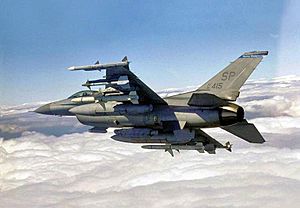January 1993 airstrikes on Iraq facts for kids
Quick facts for kids January 1993 Air Strikes on Iraq |
|||||||
|---|---|---|---|---|---|---|---|
| Part of the Iraqi no-fly zones conflict and the Persian Gulf Conflicts | |||||||
 An F-16C of the 23rd FS in 1992, similar to the one that 1st Lt. Craig Stevenson flew on Jan 17, 1993. |
|||||||
|
|||||||
| Belligerents | |||||||
|
|
|||||||
| Commanders and leaders | |||||||
|
|
|||||||
| Strength | |||||||
|
1 Kitty Hawk Class Carrier |
Numerous AAA and SAM defenses |
||||||
| Casualties and losses | |||||||
| None | 1 soldier killed | ||||||
| 3 civilians dead and 7 wounded (Iraqi claims) | |||||||
In January 1993, several countries, including the United States, United Kingdom, and France, launched air attacks against Iraq. These attacks happened because Iraq was causing problems, especially around a "no-fly zone" in its southern region. A no-fly zone is an area where certain aircraft are not allowed to fly, usually to protect people on the ground.
Contents
Why the Air Strikes Happened
After the Gulf War ended, there were worries that Iraq might try to invade Kuwait again. On August 2, 1992, Iraq's government even said on TV that Kuwait was part of Iraq. They also said they might invade again.
Iraqi soldiers also crossed into Kuwait and fought with Kuwaiti troops. Because of these actions, a "no-fly zone" was set up in southern Iraq on August 26, 1992. This zone was meant to stop Iraqi planes from flying over certain areas. Planes from the USS Independence aircraft carrier were the first to patrol this zone. Iraq had about 70 planes in this area at the time.
On December 27, 1992, two Iraqi MiG-25 fighter jets flew into the no-fly zone. An American F-16 jet shot down one of them. This was the first time an F-16 had shot down an enemy plane in air-to-air combat. It was also the first time the AIM-120 AMRAAM missile was used to shoot down a plane.
Major Air Attacks in January
January 13: Targeting Missile Sites
On January 13, 1993, Iraq moved its surface-to-air missile (SAM) sites into the no-fly zone. These missiles can shoot down planes. In response, 115 planes from the United States, United Kingdom, and France took off to attack these sites.
The planes included American F-117A stealth jets, F-16C fighters, F-111F bombers, and F-15E attack jets. British Tornado GR.1 planes and French Mirage 2000 jets also joined the mission. Many support aircraft, like AWACS planes, helped too.
About 35 planes from the USS Kitty Hawk aircraft carrier also took part. These included A-6E bombers, F/A-18A Hornets, and F-14A Tomcats. They used laser-guided bombs to hit their targets.
The targets were radar stations and air control centers at places like Tallil Air Base, Al Amara, Najaf, and Samawah. They also aimed for four mobile anti-aircraft missile sites. The attacks started around 6:45 PM and lasted only 30 minutes. Iraqi forces only fired light anti-aircraft guns.
The results of this attack were not as good as hoped. Many targets were missed. For example, out of four mobile missile batteries, only one was destroyed. Some F-117A jets had trouble hitting their targets. An Iraqi news agency later reported that one Iraqi soldier and three civilians were killed, and seven civilians were hurt.
January 17: Cruise Missile Strike and Air Combat
On January 17, the USS Kitty Hawk launched about 44 to 45 Tomahawk cruise missiles. These missiles struck the Zafraniyah Nuclear Fabrication Facility, which was about 13 kilometers (8 miles) southwest of Baghdad. Most of the missiles hit their targets. However, one Tomahawk missile was hit by Iraqi anti-aircraft fire and crashed into the Rasheed Hotel in Baghdad, killing two civilians.
On the same day, American F-16C and F-4G jets were flying reconnaissance missions. They were also providing protection for British Jaguar jets. These British jets were investigating a newly found missile site.
During this mission, an F-16C jet, flown by Lieutenant Craig Stevenson, saw an enemy plane on its radar. The enemy plane was about 30 nautical miles away and heading towards him. With help from an AWACS plane, Lieutenant Stevenson fired an AIM-120 AMRAAM missile. He shot down the enemy plane, which was first thought to be a MiG-29 but was later confirmed to be a MiG-23. This was the second time an AMRAAM missile was used to shoot down a plane, and the second air-to-air kill for an F-16.
January 19: More Incidents
On January 19, an F-4G jet fired an AGM-88 HARM missile at an Iraqi missile site near Mosul. About an hour later, an F-16C jet was shot at by Iraqi anti-aircraft guns, but it was not hit. Two hours after that, a group of F-16C jets were fired upon. They dropped cluster bombs on Iraqi guns north of Mosul. Iraq then announced a ceasefire to celebrate the inauguration of Bill Clinton as the new U.S. President, which happened on January 20.
January 21/22: New President, New Strikes
About 17 hours after President Bill Clinton took office, a team of two F-4G and two F-16C jets attacked an Iraqi missile site. This happened on January 21, 1993, at 5:09 AM EST (which was January 22, 1993, at 1:09 AM in Iraq).
The F-4G jets were escorting French Air Force Mirage F1 planes. These French planes were on a "routine monitoring mission" north of the 36th Parallel near Mosul. They were attacked by ground fire. An Iraqi missile radar then locked onto the French planes. In response, one of the F-4G jets launched an AGM-88 HARM missile about 19 kilometers (12 miles) north of Mosul.
January 23: Final Incident
On January 23, 1993, Iraqi anti-aircraft guns reportedly fired at an American A-6 Intruder jet and two F/A-18A jets from the USS Kitty Hawk. In return, the A-6 Intruder dropped a GBU-16 Paveway II laser-guided bomb, destroying the Iraqi gun.
Images for kids



